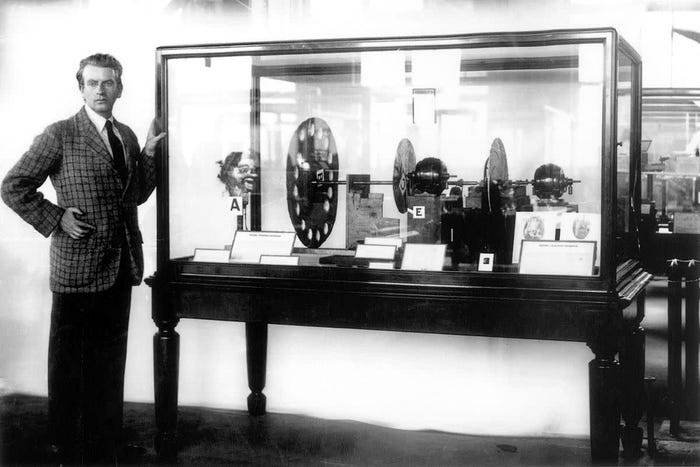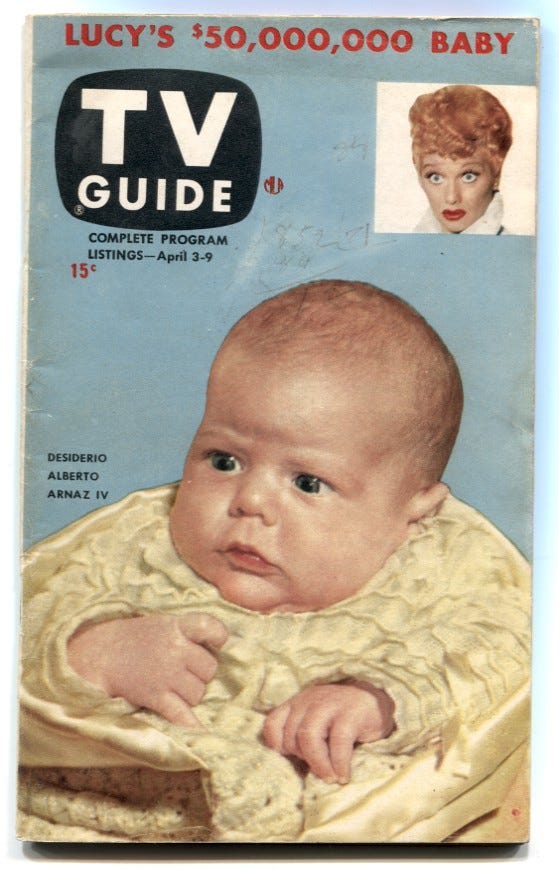The First Television Magazine- Published in 1928!

Television magazine, based in London, published its premiere issue in March of 1928, making it the first regular television publication in the world.
Just to provide some historical perspective, John Logie Baird first demonstrated his television invention in London in 1925 — and it certainly didn’t resemble what we think of as television today.
On October 2, 1925, Baird, working in his attic lab on Frith Street in the Soho section of London, used a popular ventriloquist dummy named “Stooky Bill” as his experimental television subject. He succeeded in transmitting an image of the dummy’s head as a 30-line, vertically scanned picture, at five pictures per second, to his receiver, just a few feet across the room. Under an array of intense lighting, it was the first picture transmitted with a greyscale, allowing for variations of black & white image intensity, rather than appearing as a simple silhouette devoid of any detail.
Baird quickly decided that he wanted to see a live person’s image transmitted, so he hurried downstairs to the office below in which 20-year-old clerk William Taynton was working. Taynton had expressed an interest in the experiments, so the inventor invited the lad to pose as the next televised subject, replacing Stooky Bill. After Taynton’s face appeared on the receiver screen — making him the first person ever to appear on television — Baird then took his own turn at the seat directly in front of his transmitting mechanism.
Word of his series of successful attempts to transmit discernable, live images reached the U.S. in January of 1926. On January 23, The New York Times reported from London, “John L. Baird, who has perfected television after years of research, has been giving practical demonstrations here…”
Just days later, on January 26, Baird demonstrated his apparatus for members of the Royal Institution and the press, transmitting crude images from a device on one side of a room to a receiving device on the other. In the most basic of terms, that was television. And its successful demonstration made headlines around the world.

As Television magazine founder/editor Alfred Dinsdale wrote in the first issue:
“We might, perhaps, be criticized as being premature in introducing a journal devoted solely to a subject which has as yet hardly emerged from the laboratory. But television, while it is not yet available to the general public, has long since emerged from the realm of theory; it was demonstrated in this country over two years ago, and has since been accomplished over long distances both here and in the U.S.A.”
In the U.S., the March-April 1931 issue of Television News magazine, founded and edited by Hugo Gernsback, became the first successful American publication devoted totally to TV (his first attempt in 1928 with Television magazine lasted only a few issues, due to financial setbacks and the Depression). Gernsback’s editorial in the debut issue of Television News, like Dinsdale’s in the U.K, acknowledged the perception that it might have seemed too early in television’s development to warrant a regularly published magazine:
“It is admitted that we have as yet quite a stretch to cover before we will be enabled to push a button and ‘look in’ on any program that is on the air. Yet an excellent start has been made; and the fact that there are now over twenty-seven stations broadcasting regularly should be indication enough that the new art is being taken more seriously, and that it is only a matter of time before the public will demand complete radio sets embracing the ‘visible’ as well as the audible programs.
“Up to the present time, there has been no regular periodical in this country to describe accurately from month to month the advances in television. It will be the mission of the new magazine to portray television from each and every angle and to show the reader what work has been done, not only in this country, but the world over.”
Television News merged with Radio News magazine in March of 1933 (Radio News was founded in 1919, continued publishing until 1959, before merging again, with Electronics World magazine).
An early national TV magazine, Telecast, premiered with its November, 1949 issue, comprised of photo and written features documenting those early days of network TV. It did not survive long, but the date of its demise isn’t clear. Other early TV magazines included Televiser and, of course, yet another publication simply named Television.
The best-known and most widely circulated television magazine in the U.S., TV Guide, grew out of several regional magazines purchased by Walter Annenberg’s Triangle Publications, and were then merged together to create a single, national publication.

The first issue of TV Guide was published for the week of April 3, 1953. Lucille Ball’s newborn baby, Desi Arnaz, Jr. graced the cover. As publisher Walter Annenberg wrote in that first issue:
“Television’s growing importance in our daily lives brought a need for accurate and complete station schedules printed in convenient form…the new TV Guide offers readers throughout the Nation news, features, and columns by staffs of writers in the television capitals. As a national, as well as local magazine, TV Guide will make use of the most modern printing facilities, bringing readers four-color pages — as a prelude to the day when television itself will be in color.”
The first issue included reviews of programs Robert Montgomery Presents, and Time to Smile, a photo story on Walter Winchell, a piece titled “Stars Tell ‘What TV Has Taught Me,’ “and, of course, the cover story, “Lucy’s $50,000,000 Baby.” Each subsequent issue’s mix of local schedule listings and feature stories found immediate success with subscribers.

In 1980, Panorama magazine attempted to become a national news magazine covering the creative, technical, and financial aspects of network and cable TV (think of it as Time or Newsweek for television aficionados). It did not include network or local program listings a la TV Guide, but instead presented both brief features and lengthy, in-depth interviews and investigative pieces, supported by ample artwork, photos, and eye-catching graphics. However, the ambitious publication lasted only sixteen issues, but the effort was a beautiful failure.
Until next time…
If you’ve enjoyed this article, please click the “follow” button and follow me on Medium (no charge) for more articles on popular culture, music, films, television, entertainment history, and just plain old history.
You can read more about the earliest days of television and over 100 “firsts” in TV history in my book, For the First Time on Television.
You can order a copy from this link on my website: ForTheFirstTimeOnTelevision (garryberman.com)
Other television-related articles of mine that might be of interest to you:
“Television Stars Who Went From Hits to Flops” (pt.1): https://medium.com/@garryberman/television-stars-who-went-from-hits-to-flops-c21205caa1bd
“Retro Review: Pan Am” https://medium.com/@garryberman/retro-review-pan-am-2afc7af35905
“Television’s Greatest Sitcom Dad?” https://garryberman.medium.com/televisions-greatest-sitcom-dad-ef2dab761525
“A Mother’s Day Tribute to our Funniest Sitcom Moms” https://medium.com/@garryberman/a-mothers-day-tribute-to-our-funniest-sitcom-moms-68f9122538a8
“Breaking the Fourth Wall (in comedy)” https://medium.com/@garryberman/breaking-the-fourth-wall-in-comedy-51edfa9f88f0
“Comedy to Die For: When Death Rears it’s Head in Sitcoms” https://medium.com/@garryberman/comedy-to-die-for-when-death-rears-its-head-in-sitcoms-7a51cb0acc32
“Saying Goodbye to ‘Modern Family’” https://medium.com/@garryberman/saying-good-bye-to-modern-family-73897235416d
“No Laughs, Please: Our Greatest Comedians as Dramatic Actors” https://medium.com/@garryberman/no-laughs-please-37fdf614e85a
“Fifty Years of ‘The Odd Couple’ on TV” https://medium.com/@garryberman/fifty-years-of-the-odd-couple-on-tv-part-i-62a0eac93520
“My Funny Valentine: Comedy’s Real-life Married Couples” https://medium.com/@garryberman/my-funny-valentine-comedys-real-life-married-couples-1f0605e2caca
“The First Person to be Censored on TV was…Eddie Cantor?” https://medium.com/@garryberman/eddie-cantor-the-first-person-to-be-censored-on-tv-78b56c68cae1
“Mary Kay and Johnny: Television’s First Sitcom” https://medium.com/@garryberman/mary-kay-and-johnny-televisions-first-sitcom-835fec303b5e
You can also become a member in the Medium Partner Program for a modest fee to help support my writing. https://garryberman.medium.com/membership
Please visit www.GarryBerman.com to read synopses and reviews of my books, and order them via the links to Amazon.com.
